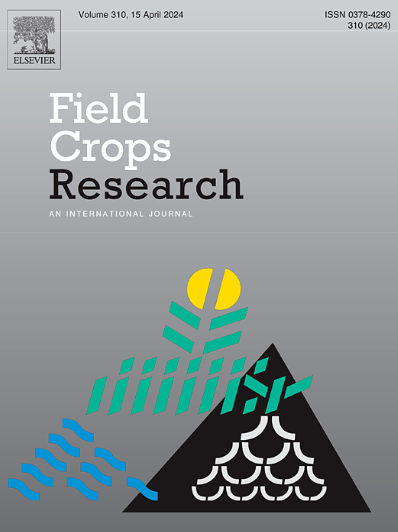利用环境分型技术和产量× 性状基因分型方法解读多性状夏玉米杂交种基因型-环境互作的作用
IF 6.4
1区 农林科学
Q1 AGRONOMY
引用次数: 0
摘要
使用高产、稳定、适应性强的夏季玉米杂交品种对全球玉米的可持续种植至关重要。然而,当代育种计划面临着识别基因型的挑战,这些基因型在不同环境中表现出一致的性能,同时保持所需的农艺特征。全球气象和地理条件的动态变化影响了中国多环境试验(METs)对夏玉米性能的评价。因此,基因型-环境相互作用(GEI)的多视角分析对于表征农业生态区玉米产量稳定性和性状表达至关重要。目的采用环境技术和多性状选择相结合的方法,对黄淮海地区玉米基因型的性能和稳定性进行综合评价。方法采用3个重复的随机完全区组设计(RCBD),对2019-2021年黄淮海地区29个地点的28个玉米杂交种和1个对照杂交种ZD958进行评价。结果基于30年(1993-2023)的环境数据,包括19个气象因子和6个土壤理化因子,ETs将8个省份的29个地点划分为6个不同的大环境(MEs)。加性主效应和乘法互作(AMMI)模型分析显示,基因型(G)、环境(E)及其互作(G×E)显著影响了2019 - 2021年各农艺参数(p <; 0.05)。采用产量× 性状(GYT)双标图法,对籽粒产量和生育期、株高、穗高、倒伏率、秃秆率、收获时籽粒含水量、穗行数、光尖长、百粒重等农艺性状在不同水稻品种间的综合表现进行了评价。GYT双图与et的整合有效地识别了不同MEs中的优势杂种。在2019 - 2021年评价的杂交种中,HY1604在MEs 1-4中表现出高产和稳定,属于高产、稳定杂交种。HY573和SD610分别在MEs 5和MEs 6的产量性状组合中表现出相对平衡的表现。对照杂交种ZD958在三年MET期内表现出较强的稳定性和平均产量表现。应用环境表征技术对夏玉米进行MEs划分,并结合GYT双标图方法对产量、适应性和稳定性进行评价,有利于品种的精准定位,为黄淮海地区夏玉米杂交种多性状综合评价提供了坚实的理论框架。本文章由计算机程序翻译,如有差异,请以英文原文为准。
Deciphering the role of genotype-by-environment interaction in summer maize hybrids based on multiple traits using envirotyping techniques and genotype by yield × trait approaches
Context
The use of high-yielding, stable, and widely adaptable summer maize hybrids is essential for the sustainable cultivation of maize globally. However, contemporary breeding programs face challenges in identifying genotypes that exhibit consistent performance while maintaining desired agronomic characteristics across diverse environments. Dynamic shifts in global meteorological and edaphic conditions have impacted the evaluation of summer maize performance in China's multi-environment trials (METs). Multi-perspective analysis of genotype-by-environment interactions (GEI) is then essential for characterizing maize yield stability and trait expression across agroecological zones.
Objective
This study aims to comprehensively evaluate the performance and stability of maize genotypes in the Huang-Huai-Hai region by integrating environmental techniques (ETs) with multi-trait selection methods.
Methods
Twenty-eight maize hybrids and a check hybrid (ZD958) were evaluated across 29 locations in the Huang-Huai-Hai region of China during the 2019–2021 cropping seasons, using a randomized complete block design (RCBD) with three replications.
Results
Based on 30 years (1993–2023) of environmental data, which included 19 meteorological and 6 soil physicochemical factors, the ETs classified the 29 locations across eight provinces into six distinct mega-environments (MEs). The additive main effects and multiplicative interaction (AMMI) model analysis revealed that genotype (G), environment (E), and their interaction (G×E) significantly influenced (p < 0.05) for all agronomic parameters from 2019 to 2021. The combined performance of grain yield and other agronomic traits—such as growth period, plant height, ear height, lodging rate, barren stalk rate, grain moisture content at harvest, ear row number, bare tip length, and 100-grain weight—across different MEs was assessed using the genotype by yield × trait (GYT) biplot approach. The integration of GYT biplots with ETs effectively identified dominant hybrids across different MEs. Among the evaluated hybrids from 2019 to 2021, HY1604 exhibited both high yield and stability in MEs 1–4, categorizing it as a high-yielding, stable hybrid. HY573 and SD610 demonstrated relatively balanced performance in yield-trait combinations in MEs 5 and 6, respectively. The control hybrid, ZD958, showed strong stability but average yield performance over the three-year MET period.
Implications
The use of environmental characterization techniques to delineate MEs, combined with the GYT biplot approach to evaluate yield, adaptability, and stability, facilitated precise variety placement, and provided a robust theoretical framework for the comprehensive evaluation of multiple traits in summer maize hybrids in the Huang-Huai-Hai region of China.
求助全文
通过发布文献求助,成功后即可免费获取论文全文。
去求助
来源期刊

Field Crops Research
农林科学-农艺学
CiteScore
9.60
自引率
12.10%
发文量
307
审稿时长
46 days
期刊介绍:
Field Crops Research is an international journal publishing scientific articles on:
√ experimental and modelling research at field, farm and landscape levels
on temperate and tropical crops and cropping systems,
with a focus on crop ecology and physiology, agronomy, and plant genetics and breeding.
 求助内容:
求助内容: 应助结果提醒方式:
应助结果提醒方式:


